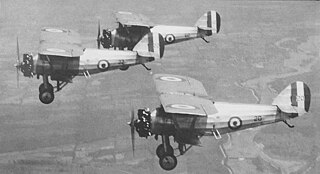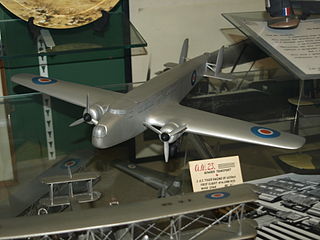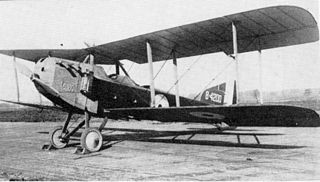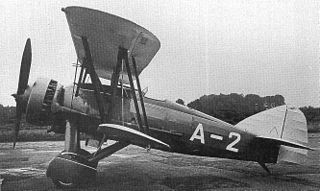
The Armstrong Whitworth A.W.41 Albemarle was a twin-engine transport aircraft developed by the British aircraft manufacturer Armstrong Whitworth and primarily produced by A.W. Hawksley Ltd, a subsidiary of the Gloster Aircraft Company. It was one of many aircraft which entered service with the Royal Air Force (RAF) during the Second World War.

The Armstrong Whitworth Siskin was a biplane single-seat fighter aircraft developed and produced by the British aircraft manufacturer Armstrong Whitworth Aircraft. It was also the first all-metal fighter to be operated by the Royal Air Force (RAF), as well as being one of the first new fighters to enter service following the end of the First World War.

The Fairey Gordon was a British light bomber and utility aircraft of the 1930s.

The Ape was a British biplane experimental aeroplane built by Armstrong Whitworth Aircraft in the early 1920s and first flown on 5 January 1926 to "answer all the questions of aerodynamics."

The Armstrong Whitworth A.W.23 was a prototype bomber/transport aircraft produced to specification C.26/31 for the British Air Ministry by Armstrong Whitworth Aircraft. While it was not selected to meet this specification, it did form the basis of the later Armstrong Whitworth Whitley aircraft.

The Armstrong Whitworth F.K.3 was a British two-seat general-purpose biplane built by Armstrong Whitworth Aircraft during the First World War. By the end of the war it was considered obsolete for combat.

The Armstrong Whitworth F.K.8 was a British two-seat general-purpose biplane built by Armstrong Whitworth during the First World War. The type served alongside the better known R.E.8 until the end of the war, at which point 694 F.K.8s remained on RAF charge.

The Westland Walrus was a British spotter/reconnaissance aircraft built by Westland Aircraft.

The Armstrong Whitworth Atlas was a British single-engine biplane designed and built by Armstrong Whitworth Aircraft. It served as an army co-operation aircraft for the Royal Air Force (RAF) in the 1920s and 1930s. It was the first purpose-designed aircraft of the army co-operation type to serve with the RAF.

The Armstrong Whitworth A.W.35 Scimitar was a British single-engine biplane fighter aircraft designed and built by Armstrong Whitworth Aircraft. Four Scimitars were produced for the Norwegian Army Air Service and were delivered in 1936.

The Armstrong Whitworth A.W.16 was a British single-engine biplane fighter aircraft designed and built by Armstrong Whitworth Aircraft. A number were sold to the Chinese Kwangsi Air Force.

The Armstrong Whitworth F.K.10 was a British two-seat quadruplane fighter aircraft built by Armstrong Whitworth during the First World War. While it was ordered in small numbers for the Royal Flying Corps and Royal Naval Air Service, it was not used operationally. It is one of the few quadruplane aircraft to reach production.

The Armstrong Whitworth A.W.14 Starling was a British single-engine biplane fighter developed for the Royal Air Force in the 1920s. The plane was an unsuccessful model, with the Bristol Bulldog being selected instead.

The Bristol Bloodhound was a British two-seat reconnaissance/fighter aircraft designed and built by the Bristol Aeroplane Company as a possible replacement for the Bristol F.2 Fighter for the Royal Air Force. It was unsuccessful, only four prototypes being built.
The Armstrong Whitworth Armadillo was a British single-seat biplane fighter aircraft built by Armstrong Whitworth.
The Armstrong Whitworth Ara was an unsuccessful British single-seat biplane fighter aircraft of the First World War built by Armstrong Whitworth.

The Armstrong Whitworth A.W.19 was a two/three-seat single-engine biplane, built as a general-purpose military aircraft in the mid-1930s. A newer, monoplane aircraft was preferred and only one A.W.19 was built.
The Armstrong Whitworth A.W.29 was a British bomber aircraft built by Armstrong Whitworth Aircraft.

The de Havilland DH.56 Hyena was a prototype British army cooperation aircraft of the 1920s. A single-engined biplane, the Hyena was designed against an RAF requirement, but was unsuccessful with only two being built, the Armstrong Whitworth Atlas being preferred.

The Vickers Type 253 was a single-engined two-seat biplane general-purpose military machine built to a 1930 government specification. It won a production contract, but this was transferred to the same company's monoplane equivalent, the Wellesley. Only one Type 253 was built.

















